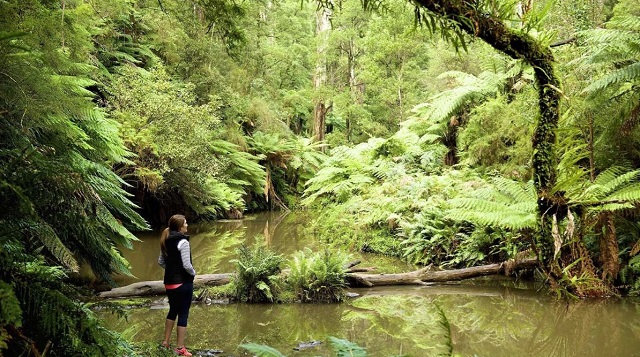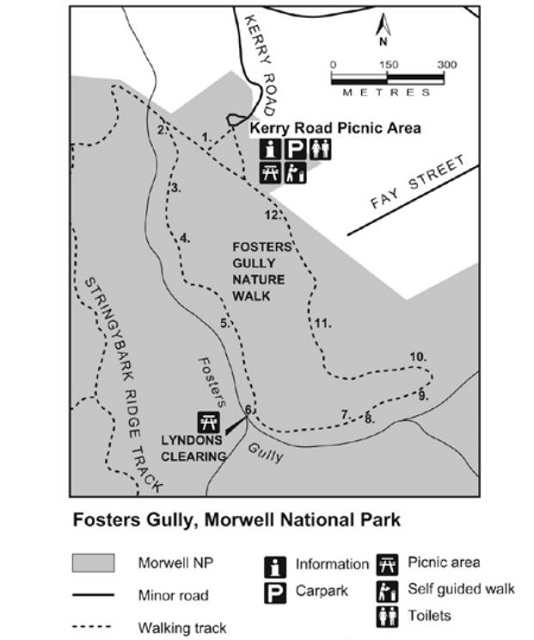Yinnar South - Morwell National Park


This small unique area of remnant forest in the northern foothills of the Strzelecki Ranges is best known as a habitat for over 40 species of native orchids. Ideal for a picnic lunch, a short stroll or a full day bushwalk. Wildlife is plentiful in the park with wallabies, wombats, possums, kangaroos and koalas sighted frequently.
The best was to enjoy Morwell National Park is to walk through it. Fosters Gully Nature Walk provides an excellent introduction to the park.
Facilities include picnic area, toilets, water, wood BBQ and tables.
Things to see and do
The best way to enjoy Morwell National Park is to walk through it. Fosters Gully Nature Walk and Stringybark Ridge Track depart from the Kerry Road Picnic Area. Interesting walks can also be found in the Billys Creek area of the park. The main track commences at a small car park on Junction Road where walking track information is available.
Alternatively, relax at the Kerry Road Picnic Area. Fine views across the Latrobe Valley can be seen from the Jumbuk Road south of the Junction Road turnoff.
Fosters Gully Nature Walk
Take a journey of discovery along the Fosters Gully Nature Walk where the forests and undergrowth provide food and shelter for many species of birds and animals. If you are quiet you may be able to see and hear many of the species of wildlife that live in the park. The walk commences at the Kerry Road picnic area and is approximately 2.3km long and takes about an hour at an easy walking pace.
As you walk along the track, the numbers refer to pegs along the track.

1. Forest of the future
Here, on the left of the track you can see young Varnish Wattles and Grey Gums that have regenerated on an area cleared in 1970.
This area is a valuable habitat for small native mammals such as bush rats and marsupial mice. A short distance further along, turn right at the firebreak, then left at the Fosters Gully sign
2. Forest homes and storeys
This huge Mountain Grey Gum is probably over 200 years old. It is 6.5 metres in circumference and nearly 60 metres high. Mature or over-mature trees like this one have numerous holes where branches have broken off. Birds such as Rosellas, and mammals like Brush-tailed Possums, make their homes in the hollows.
In this forest, Grey and Blue Gums form the canopy or upper level of vegetation. Below this are Pittosporum, Hazel Pomaderris, Blanketleaf and other trees of medium height. Then come lower-growing plants such as Treeferns, Cassinia and creepers which can grow in the heavy shade of the taller species and finally ground plants like ferns and mosses. These vegetation levels are often called storeys.
3. Land of the Lyrebird
You have now entered the habitat of the superb Lyrebird. Lyrebirds are ground-feeding birds, feeding on worms, snails and insects found in the forest litter, and you will probably see places along the track where they have been scratching in the soil. It is the male Lyrebird which has a varied and powerful song - including the mimicry of other bird songs.
4. Different trees
Here another eucalypt grows - the Messmate. Its name was given in Captain Cook's day and can be readily identified by its leaves, which form an oblique angle across the stem.
The scratching on this and other trees in the park are caused by either Ring-tailed possums building nests or Sugar-gliders gliding from tree to tree in search of sap, nectar and insects living in the trees.
5. Old quarry
The area on the left was used as a sand and gravel quarry in the 1920's, but the scars of mining have since been healed by nature.
Spend a little time here on the seats and you should see and hear some of the park's rich birdlife like Honey-eaters, Eastern Spinebills and White-throated Tree-creepers. About 150 meters further along the track, turn right at the sign to Lyndon's Clearing.
6. Lyndon's Clearing
This is a good place for lunch at the table provided, or you can just sit back on the seats and watch the birds. Wedge-tailed Eagles can often be seen high overhead and many small bush birds frequent the clearing.
Lyndon's Clearing is named after Mrs Ellen Lyndon of Leongatha, who previously lived on a farm near here. Her studies of the plant and animal life of this forest established its significance, and together with the Latrobe Valley Field Naturalists Club was instrumental in having the park proclaimed in 1967.
7. Ferns and sedge
This damp south-facing area is a home for ferns including Gristle Fern, and Soft and Rough Tree Ferns.
8. Black stump
The tall burnt stump here is probably a relic of the bush fires which burnt large areas of Strzelecki's forest in 1946. Areas like Fosters Gully were burnt perhaps only once every two or three hundred years and natural regeneration returned the forest to its former glory.
9. Aspect
You can rest on the seat here and look across the gully. The effects of the position of the sun or aspect can be plainly seen. The slope you are climbing faces south, so is sheltered from direct sunlight and drying northerly winds. It supports shade loving species like ferns and Victorian Christmas Bush.
Across the gully, the slope faces north and receives full sunlight for most of the year. The canopy species of Grey Gum and Blue Gum are still the same, but the understorey species are mainly bracken and grasses and are much sparser.
10. Messmate ahoy!
You have now left the Grey Gum forest of the gully and are entering the drier Stringybark forest of the higher slopes. The most common tree here is the Messmate. Along this part of the track in winter, many kinds of fungi and mosses can be seen on the logs and on the ground.
11. Cherry Ballart
The Cherry ballart is not a eucalypt but is a common species in Victorian Stringybark forests. It can be recognised by the fruit which grows at the end of swollen stems which are the 'cherries' and it obtains some of its nutrients from the roots of nearby plants.
As you follow the trail look for our native orchids: Pink Fingers and Waxlips in the spring; Hyacinth orchids and Cinnamon Bells in the summer; and Parson's Bands and Autumn Bird orchids in the autumn. They thrive in this light sandy soil and open forest.
12. Firebreak
This wide firebreak is not a particularly attractive feature of this park, but is a necessary part of park management. It helps to prevent fires from entering the park and protects neighbouring private properties from fire.
Here you will also see a different tree species. It is an Apple Box or But But found in forests in Gippsland and north eastern Victoria. Return down the hill to the picnic area and the start of the walk.
Billys Creek Area
The Billys Creek area is one of great natural beauty with high scenic values and relics of past land uses. Areas of remnant Strzelecki Ranges vegetation can be seen, along with previously degraded areas which have been rehabilitated. Over 30,000 trees have been planted on the creek flats between Junction Road and the Billys Creek weir. Recreational activities include picnicking, bird watching, nature study and bushwalking. Walking tracks include:
Billys Creek Track - 1.5 km
From Junction Road Car park to But But Track.
A pleasant walk along the creek flats beside Billys Creek, passing through areas which have been revegetated over the past 20 years. Some excellent remnant vegetation can also be seen along the creek banks, including Manna Gum, Blue Gum, Swamp Gum and the vulnerable Strzelecki Gum.
Weir Track - 800 m
From But But Track to Billys Creek Weir
The track crosses several footbridges over the creek and passes through some superb stands of Manna Gum before arriving at the old weir. The weir was built in 1914 and once supplied water to Morwell via a wooden pipeline. An easy walk suitable for the whole family.
Lodge Track - 2 km
From Billys Creek Weir to Morans Road
This track climbs steeply up a ridge through a variety of forest types containing Blue Gum, Mountain Grey Gum, Messmate and Apple Box (But But). A strenuous walk, but the views from the higher areas of the park make it worthwhile.
Clematis Track - 1.2 km
From Billys Creek to Lodge Track
Climbing through a damper forest type which contains Blackwoods and Musk-daisy bush, this track joins Lodge Track half way up on its climb to Morans Road, but is not quite as steep. Clematis and Wonga Vine can be seen flowering profusely all along this track in early spring.
Blue Gum Hill Track - 3 km
From Billys Creek Weir to Blue Gum Hill and return
Blue Gum Hill Track starts a short distance along Lodge Track, and then follows a small creek for 500m before beginning the climb up Blue Gum Hill. On the way to the top, the track passes through disturbed areas, which were once cleared for grazing, as well as some fine stands of Blue Gums. After climbing for 1.2 kilometres, the summit is reached and, although there is no formal lookout, the views from this area are spectacular. Looking out over Billys Creek and the surrounding steep hills, the Latrobe Valley can be seen in the distance.
Return via the same route or take the track to the West, which follows a steep spur down to Billys Creek and back to the weir. Care must be taken as this track is extremely steep.
Zig Zag Track - 1.2 km
From Weir Track to Jumbuck Road
An alternative route into the weir area from Jumbuck Road.
Facilities and Accommodation
Picnic tables, gas barbeque, toilets and information are provided at the Kerry Road Picnic Area. Picnic tables are at Lyndons Clearing and Billys Creek. Camping is not permitted. Accommodation is available in Churchill or Morwell.
Access for Dogs:
Cats and dogs are not permitted within the park.
How to get there
The park is situated 16km south of Morwell and is reached via Churchill or Yinnar. It is a pleasant two hour drive from Melbourne.
Note: Photos from Parks Victoria
Location
Jumbuk Road, Yinnar South 3869 Map
Web Links
→ Morwell National Park (Parks Victoria)
→ Morwell National Park - Park note (PDF)
→ Morwell National Park Map (PDF)











